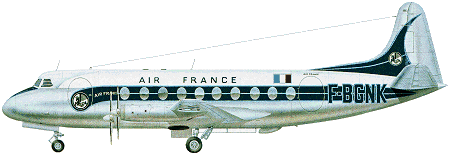 |
Vickers Viscount1948 |  |
| TRANSPORT, PASSENGER | Virtual Aircraft Museum / United Kingdom / Vickers |
 |
During World War II the US had gained a considerable start in the design and development of long-range transport aircraft. To Britain the Viscount represented the belief and hope that its lead in the new turbine engine allied to the industry's enthusiasm would erode some of America's advantage in post-war civil aviation. That this hope failed to materialise was due to a number of factors and space does not allow, for their discussion here. Suffice it to say that production exceeded 440 aircraft and orders from Capital Airlines of Washington for 60 aircraft represented a major triumph for the British aircraft industry. The origin of the Viscount can be traced back to the war-time Brabazon Committee, which was charged with the task of steering Britain's aircraft industry in the right direction in the immediate post-war years. One of its recommendations was the development of a turboprop-powered short/medium-range airliner (identified originally as the Brabazon IIB), and in April 1945 Vickrrs were instructed to proceed with its design and development, then identified by the company as the VC2 project. This was the first of the company's designs to be brought to fruition under the leadership of George (later Sir George) Edwards, following the death of Rex Pierson. The project undoubtedly benefited from the fact that Edwards was facing his first major design/production challenge, one which he met with tremendous practical ability and enthusiasm. As finalised, a circular-section pressurised fuselage was chosen with low-set monoplane wings, a Vickers-style tail unit, retractable tricycle-type landing gear and four of Rolls-Royce's new Dart turboprops. Despite the efforts of Edwards, his design team and Vickers' engineers, interest in the project waned when BEA had doubts about the aircraft's economics in the autumn of 1947. Enthusiasm was at a low ebb when the Viscount 630 prototype flew for the first time on 16 July 1948. Its smooth performance and superb handling qualities left no doubt that the company had produced an exceptional aeroplane, and with BEA's co-operation a higher gross weight/increased capacity specification for 43 passengers was drawn up. A prototype of this new version was ordered by the Ministry of Supply in February 1949. By the time this flew for the first time on 28 August 1950, BEA had already bolstered Vickers' enthusiasm by ordering 20 (later 26) Viscount 701s on 3 August. It was the beginning of a success story: the world's first turbine-powered aircraft to operate a revenue passenger service, and the first to demonstrate the smooth reliability of turbine power plants to a new generation of passengers who would soon be travelling across the face of the earth for both business and pleasure.

|  COMPANY PROFILE | |||||||||||||||||||||||||||||||||||||||||||||||||||||||||
 |

|

